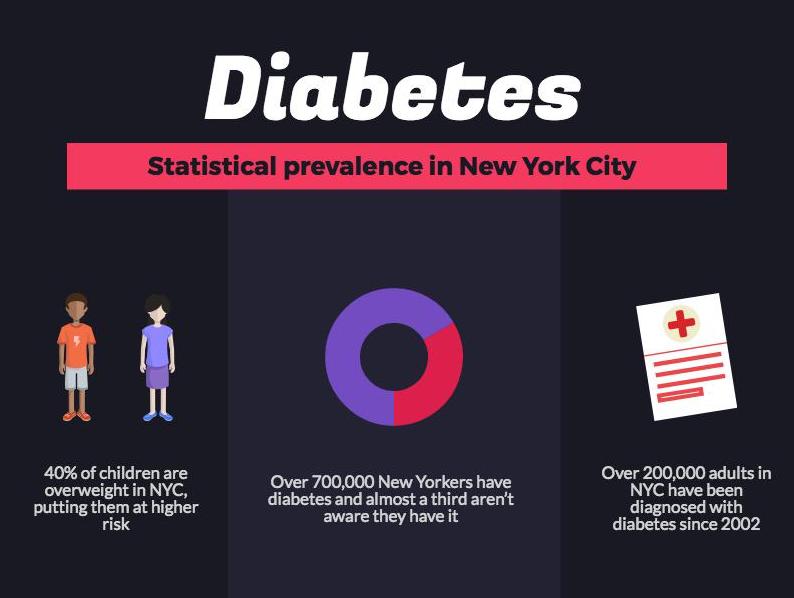
Diabetes continues to be a growing issue in New York City. Cases are on the rise and many New Yorkers are undiagnosed. Credit: Lisa Kocay.
By Lisa Kocay
When Michael Monti goes out to eat, he asks his server what’s in his food. He avoids most Asian sauces, excess butter, carbohydrates and marinara – a challenge because he’s Italian.
Monti, now 26, was 19-years-old when he learned he had to change his eating habits because of Type 1 diabetes.
“When I first became diabetic, I was hitting the peak of having fun in my life,” he said. “I was a horrible diabetic at first because I felt like I was invincible, and diabetes hit me with a slap in the face.”
The American Diabetes Association says that Type 1 diabetes, in which the body fails to produce insulin, is most commonly found in children and young adults. About 1.25 million Americans have Type 1, with about 40,000 people new cases diagnosed each year, representing five percent of the diabetic population. Type 2 is far more common, and linked to obesity.
Over 700,000 New Yorkers have diabetes and almost a third aren’t aware they have it, according to New York City Health. A 2013 report said that cases more than doubled between 1993 and 2011. Forty percent of children are overweight, putting them at higher risk for a Type 2 diagnosis.
Sandy Narayanan, co-founder and executive director at Marjorie’s Fund, a Type 1 diabetes global initiative, and the founder and president of CoreCise health club, said that moderating carbohydrate, sugar and portion sizes is necessary for maintaining blood sugar levels. Certain ethic cuisines, including Mexican, Indian, Italian and Chinese, tend to be carbohydrate dense because of rice, so she suggests that people with diabetes opt for healthier choices, like salad.
“With Type 1, the challenge is you have to monitor constantly,” she said. “You have to think for your pancreas because your pancreas isn’t producing any insulin.”
A person’s blood sugar can react differently to the same meal on a different day based on other variables, like exercise or whether they’re sweating more because it’s hot outside, she said.
Narayanan said that food doesn’t affect the body as immediately in Type 2 diabetes, so people may underestimate their carbohydrate intake and have issues later on.
Sophia Aslanis, founder of nutrition center Nutrition4Life, said people with diabetes can enjoy indulgent foods, like cake, if they watch portion control and balance the rest of their diet.
Monti has managed to come to terms with his illness — “It’s one disease that’s very manageable as long as you stay on top of it,” he said. He tries to regulate his sugar by opting for protein and greens, but said it’s challenging when eating out.
Hidden ingredients can make restaurant meals harder to navigate. Lay Alston, chef de partie at Café Boulud, said restaurants often add sugar to proteins, sauces and marinades. She formerly worked at a Japanese restaurant, where, she says, an oyster dish with teriyaki sauce was full of sugar from the sauce.
Monti also has to watch his alcohol intake. He said he can enjoy a glass of wine with dinner, but can’t have liquor or beer because they’re too high in carbohydrates for him. Narayanan says alcohol can be hypoglycemic and reduce blood sugar. The American Diabetes Association notes people with diabetes should check their blood sugar while drinking and up to 24 hours after drinking, and consume food when necessary. Monti says if his blood sugar level gets too high or too low, he risks going into a coma.
“I was about to hit the prime-time of life,” he said. “I was about to start drinking, going out with friends, having fun, and that basically just had to come to a stop right on a dime.”
The American Diabetes Association states the estimated total costs of diabetes rose from $174 billion in 2007 to $245 billion in 2012, a 41 percent increase. Direct medical costs amounted to $176 billion out of $245 billion, and people with diagnosed diabetes spend about $13,700 per year on medical expenditures, with $7,900 attributed to diabetes. The average medical expenditure for a person with diabetes is 2.3 times higher than for a person without diabetes, and New York State has the third highest population of people with diabetes.
Narayanan said she expects the number of cases to continue increasing. Aslanis, though, believes the number will go down because more doctors and nutritionists are testing for pre-diabetes.
Monti uses Dexcom Continuous Glucose Monitoring, a sensor placed under the skin with an attached transmitter that sends wireless data to a display device, to test his glucose throughout the day, so he only pricks his finger twice instead of at every meal. He said he knows when his blood sugar levels are dropping or rising, though.
“When you get a low blood sugar, you’re basically not responsive,” he said. “You’re out of it, you’re sweating; it’s crazy. You don’t want to do a thing. Your eyesight gets blurry and you’ll feel when your number is dropping, when it’s going down low, and vise versa when it’s going high. When I flex my muscles, my body feels like it’s about to cramp up. When you stretch for too long, or have your leg straight for too long and it starts to cramp up, that’s how it feels.”
“Just to cope with the feeling you have to live with a disease for the rest of your life, it’s pretty rough,” he said. “But at the end of the day, you also got to think in the back of your mind that there’s somebody out there who has it a lot worse.”
Tags: diabetes, health
Your Comments